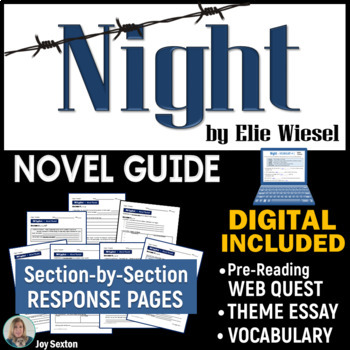NIGHT by Elie Wiesel - Novel Guide - Print & DIGITAL
- Zip
- Google Apps™
- Internet Activities

What educators are saying
Description
NIGHT - This Novel Guide for Elie Wiesel’s Night will keep students thinking and enhance their understanding from the first page of the book to the last. Now includes a DIGITAL version! Section-by-Section Response Pages challenge students to dig into the text to explain and make inferences as they read. Includes a pre-reading Web Quest, Theme Essay writing assignment, and Vocabulary study.
The DIGITAL version offers colorful slides that allow students to type their responses into text boxes.
To access the DIGITAL version of this resource, you will find:
--a PDF containing links to every resource listed
--directions for uploading the resources and using them with students
With both a print-and-go version AND digital, you'll be equipped for all teaching situations! Plus, you'll be able to differentiate according to your students' needs.
--------------------------------------------------------------------------------------------------------------------------------
Resource Contents:
1. SECTION-BY-SECTION RESPONSE PAGES – The Response Pages contain questions and prompts in varied formats that reflect standards-based skills such as citing text details and evidence, making inferences, analyzing figurative language, author’s tone, characters’ points of view, etc. Students enjoy working on these with a partner or in small groups—they are a great way to get students discussing the novel. (12 pages, 34 slides)
2. VOCABULARY STUDY – Twenty vocabulary words from the book are presented, five per page, with definitions provided. Students study the definitions, and then sentences are given with context clues. Students write the correct word in the appropriate sentence and then choose two words from that page to illustrate meanings. (4 pages, 8 slides)
3. PRE-READING WEB QUEST – Students engage in a short research activity using two web sites (given) to view pictures and read background information about the concentration camps where Elie Wiesel was sent. Students take notes and also provide reflection. (2 pages, 3 slides)
4. THEME ESSAY ASSIGNMENT – This end-of-the-book writing assignment engages students with various themes from Night, allows for choice, includes a graphic organizer for pre-writing, and focuses on the development of theme with an emphasis on text-based evidence. I have included two versions of this essay assignment for differentiation. One version requires a 5-paragraph essay (three body paragraphs), and the other version requires a 4-paragraph essay (two body paragraphs). (4 pages, 14 slides)
5. THEME ESSAY GRADING RUBRIC – A 4-Point Rubric is provided for grading the theme essay. (1 page, 2 slides)
6. TEACHER GUIDELINES and ELA STANDARDS – Directions and tips are offered for using the materials in this Novel Guide along with a listing of standards addressed. (3 pages)
7. ANSWER KEYS – A full answer key is included for the Section-by-Section Response Pages (both versions), Vocabulary (both versions), and the Web Quest. (22 pages)
NOTE: Since Elie Wiesel now has two versions of his book available for us to teach, I have included the Section-by Section Response Pages and Vocabulary Pages for the NEW TRANSLATION, and also a set to go along with the OLD TRANSLATION. That is why when you download the product, two sets of these resources will be found.
The STANDARDS-BASED SKILLS reflected in this product are :
*Citing textual evidence involving characters, setting, and events
*Making inferences from the text
*Analyzing dialogue / what dialogue reveals about character
*Analyzing the development of theme
*Examining author's tone and word choice
*Determining the meaning of new words including figurative and connotative meanings
*Write informative/explanatory texts
*Conduct short research activities
Please open the PREVIEW!
Thanks, --Joy
You might also like:
Short Response for ANY Literature - DIGITAL Distance Learning- Differentiated
Character Traits Essay - DIGITAL for Distance Learning - Literary Essay Writing
ELA Test Prep STATIONS for ELA Test Practice - Print & Digital Distance Learning
---Yes! Join my list to receive Teaching Tips, New Product Updates, and FREEBIES from Joy





